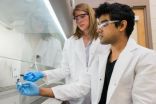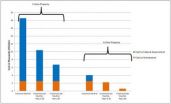(Press-News.org) University of Delaware researchers have identified a protein, hiding in plain sight, that acts like a bodyguard to help protect and stabilize another key protein, that when unstable, is involved in Crohn's disease. The fundamental research points to a possible pathway for developing an effective therapy for the inflammatory bowel disease.
The research, by Catherine Leimkuhler Grimes, assistant professor of chemistry and biochemistry at UD, and Vishnu Mohanan, doctoral student in biological sciences, is published in the July 4 issue of the Journal of Biological Chemistry. The study was funded by a grant from the National Institutes of Health (NIH).
As the scientists point out, our immune system provides the first line of defense against invading pathogens, a task even more challenging in the human gut, where over a trillion commensal bacteria live — resident microorganisms that help convert food into protein, vitamins and minerals.
To distinguish "bad" versus "good" bacteria, our bodies rely on a complex network of receptors that can sense patterns that are unique to bacteria, such as small fragments of bacterial cell wall. The receptors recognize and bind to these fragments, triggering an immune response to take out the "bad guys" or control the growth of the "good guys."
However, when one of these receptors breaks down, or mutates, an abnormal immune response can occur, causing the body to mount an immune response against the "good" bacteria. Chronic inflammatory disorders, such as Crohn's disease, are hypothesized to arise as a result.
The UD team focused on a protein called NOD2 — nucleotide-binding oligomerization domain containing protein 2. More than 58 mutations in the NOD2 gene have been linked with various diseases, and 80 percent of these mutations are connected specifically to Crohn's disease, according to Grimes.
In experiments to unveil NOD2's signaling mechanisms and where they break down, "we stumbled on this chaperone molecule," says Mohanan, who was the lead author of the scientific article.
The chaperone molecule was HSP70, which stands for "heat shock protein 70." It assists with the folding of proteins into their correct three-dimensional shapes, even when cells are under stress from elevated body temperatures, such as a fever.
Grimes said she was a little skeptical at first about pursuing studies with HSP70 because it is a commonly known protein, but she found Mohanan's initial data intriguing.
"Vishnu found that if we increased the expression level of HSP70, the NOD2 Crohn's mutants were able to respond to bacterial cell wall fragments. A hallmark of the NOD2 mutations is inability to respond to these fragments. Essentially, Vishnu found a fix for NOD2, and we wanted to determine how we were fixing it."
In further experiments, Mohanan created a tagged-wild-type NOD2 cell line in which NOD2 levels nearly matched the levels found in nature (versus "super" levels that might stimulate an artificial response) and found that NOD2 became more stabilized and degraded more slowly when treated with HSP70. In fact, HSP70 increased the half-life of NOD2 by more than four hours.
"Basically, HSP70 keeps the protein around — it kind of watches over and protects NOD2, and keeps it from going in the cellular trash can," Grimes explains.
The researchers tested three human cell lines in their study: kidney cells, colon cells and white blood cells. In the next phase of the study, patient tissue will be examined through a collaboration with Nemours/A.I. duPont Hospital for Children to determine if NOD2 levels can be controlled via HSP70 expression.
"We want to figure out why the mutation in NOD2 results in an increase in inflammation," says Mohanan. "Right now, we have limited knowledge. Once the signaling mechanism is figured out, we will have the keystone."
Mohanan, who is from the state of Kerala in south India, previously was involved in brain cancer research at UD. He co-authored a journal article in the field, but wanted to further his knowledge and skills through interdisciplinary study.
When the opportunity arose to work with Grimes, Mohanan says he jumped at the chance. He was the first graduate student to join Grimes's laboratory group in the Department of Chemistry and Biochemistry two years ago, which now includes 13 budding scientists, from postdoctoral fellows and doctoral students to undergraduates. Grimes, who did her graduate work at Princeton and Harvard, recently was named a 2014 Pew Scholar in the Biomedical Sciences.
Based on its increasing incidence worldwide, Crohn's disease has been identified as an emerging global disease. In the United States alone, as many as 700,000 people may be afflicted, predominantly adolescents and young adults between 15 and 35 years of age, according to the Crohn's and Colitis Foundation of America.
Identifying proteins that interact and stabilize NOD2 is a first step to developing novel therapies to treat Crohn's disease, the UD research team says.
INFORMATION:
This research was supported by NIH Grant P20GM103541 from the National Institute of General Medical Sciences.
Crohn's disease research
UD scientists sleuth out proteins involved in Crohn's disease
2014-07-17
ELSE PRESS RELEASES FROM THIS DATE:
Carnegie Mellon combines hundreds of videos to reconstruct 3D motion without markers
2014-07-17
PITTSBURGH—Carnegie Mellon University researchers have developed techniques for combining the views of 480 video cameras mounted in a two-story geodesic dome to perform large-scale 3D motion reconstruction, including volleyball games, the swirl of air currents and even a cascade of confetti.
Though the research was performed in a specialized, heavily instrumented video laboratory, Yaser Sheikh, an assistant research professor of robotics who led the research team, said the techniques might eventually be applied to large-scale reconstructions of sporting events or performances ...
Incidence of stroke in the elderly has dropped by 40 percent over the last 20 years
2014-07-17
Philadelphia, PA, July 17, 2014 – A new analysis of data from 1988-2008 has revealed a 40% decrease in the incidence of stroke in Medicare patients 65 years of age and older. This decline is greater than anticipated considering this population's risk factors for stroke, and applies to both ischemic and hemorrhagic strokes. Investigators also found death resulting from stroke declined during the same period. Their findings are published in the July issue of The American Journal of Medicine.
Preventable but deadly, stroke is the fourth leading cause of mortality in the ...
NYU Langone investigators to present new research at 2014 Alzheimer's Association International Conference
2014-07-17
(New York, NY, July 12, 2014) - Researchers from the Center for Cognitive Neurology (CCN) at NYU Langone Medical Center, NYU School of Medicine, and the Nathan S. Kline Research Institute will present new findings at the 2014 Alzheimer's Association International Conference in Copenhagen, Denmark, July 12 – 17, 2014.
The Center for Cognitive Neurology is a multidisciplinary, integrated center devoted to research, clinical care and clinical advances toward the treatment and cure of neurological diseases affecting cognition -- focused on memory, language, attention, auditory, ...
The rate at which groundwater reservoirs are being depleted is increasing
2014-07-17
FRANKFURT.In what parts of the world and to what degree have groundwater reservoirs been depleted over the past 50 years? The Frankfurt hydrologist Prof. Petra Döll has been researching this using the global water model WaterGAP. She has arrived at the most reliable estimate to date by taking into consideration processes which are important in dry regions of the world. The values calculated were compared with monitoring data from many different wells and data from the GRACE satellites. These satellites measure changes in the Earth's gravity field. Döll has come to the conclusion ...
What are the risks of post-traumatic stress disorder after an accident?
2014-07-17
This news release is available in French. Many patients continue to suffer from symptoms (headaches, pain) several months after an accident, which can pose a real handicap to their lives. The team of Emmanuel Lagarde, research director at Inserm's Research Centre for Epidemiology and Biostatistics (Inserm/University of Bordeaux) has studied the subsequent development of 1,300 people who were admitted to A&R between 2007 and 2009 for trauma. The researchers demonstrate that it is possible to identify people who will develop post-traumatic stress disorder, which generally ...
Danish DNA could be key to happiness
2014-07-17
Genetics could be the key to explaining nation's levels of happiness, according to research from the University of Warwick.
Economists at the University's Centre for Competitive Advantage in the Global Economy (CAGE) have looked at why certain countries top the world happiness rankings. In particular they have found the closer a nation is to the genetic makeup of Denmark, the happier that country is. The research could help to solve the puzzle of why a country like Denmark so regularly tops the world happiness rankings.
Dr Eugenio Proto and Professor Andrew Oswald ...
Potential new therapy with brain-on-a-chip axonal strain injury model
2014-07-17
University of Houston researchers have devised a new method for extracting molecules from live cells without disrupting cell development, work that could provide new avenues for the diagnosis of cancer and other diseases.
The researchers used magnetized carbon nanotubes to extract biomolecules from live cells, allowing them to retrieve molecular information without killing the individual cells. A description of the work appears this week in the Proceedings of the National Academy of Sciences.
Most current methods of identifying intracellular information result ...
Is the US National Flood Insurance Program affordable?
2014-07-17
There is often tension between setting insurance premiums that reflect risk and dealing with equity/affordability issues. The National Flood Insurance Program (NFIP) in the United States recently moved toward elimination of certain premium discounts, but this raised issues with respect to the affordability of coverage for homeowners in flood-prone areas. Ultimately, Congress reversed course and reinstated discounted rates for certain classes of policyholders.
Carolyn Kousky (Resources for the Future, USA) and Howard Kunreuther's (The Wharton School, University of Pennsylvania, ...
Plasmon-enhanced Polarization-selective filter
2014-07-17
As we all know, some optical devices can only work with a certain incident polarization direction. In this case, a polarizer is necessary to shift the polarization direction of linearly polarized light. A common polarizer is also called half-wave plate, which constructed out of a birefringent material (such as quartz or mica). The behaviour of a half-wave plate depends on the thickness of the crystal, the wavelength of light. Considering the fabrication of crystal, a half-wave plate is difficulty to integrate on circuits. Then what kind of polarizer can be integrated on ...
Do urban casinos increase local crime? Not in this case study
2014-07-17
Philadelphia's SugarHouse Casino opened its doors in September 2010 after years of protests from community members who feared that the casino would lead to an increase in neighborhood crime. However, a new study by researchers at Drexel University and Temple University reveals that these concerns were unfounded.
The study, which used geolocated crime data to examine changes in crime volume in the immediate neighborhood of the casino since its opening, found that crime rates in the Fishtown neighborhood of Philadelphia were largely unaffected by the introduction of the ...
LAST 30 PRESS RELEASES:
$80 million in donations propels UCI MIND toward world-class center focused on dementia
Illinois research uncovers harvest and nutrient strategies to boost bioenergy profits
How did Bronze Age plague spread? A sheep might solve the mystery
Mental health professionals urged to do their own evaluations of AI-based tools
Insufficient sleep associated with decreased life expectancy
Intellicule receives NIH grant to develop biomolecular modeling software
Mount Sinai study finds childhood leukemia aggressiveness depends on timing of genetic mutation
RSS Research Award for new lidar technology for cloud research
Novel AI technique able to distinguish between progressive brain tumours and radiation necrosis, York University study finds
Why are abstinent smokers more sensitive to pain?
Alexander Khalessi, MD, MBA, appointed Chief Innovation Officer
Optical chip pioneers physical-layer public-key encryption with partial coherence
How your brain understands language may be more like AI than we ever imagined
Missed signals: Virginia’s septic strategies overlook critical timing, study warns
Delayed toxicities after CAR T cell therapy for multiple myeloma are connected and potentially preventable
Scientists find cellular key to helping plants survive in saltwater
Medical cannabis program reduces opioid use
Immunotherapy works for sepsis thanks to smart patient selection
Cardiovascular events 1 year after RSV infection in adults
US medical prices and health insurance premiums, 1999-2024
Medical cannabis and opioid receipt among adults with chronic pain
Multichannel 3D-printed bioactive scaffold combined with siRNA delivery for spinal cord injury recovery
Triaptosis—an emerging paradigm in cancer therapeutics
A new paradigm in spectroscopic sensing: The revolutionary leap of SERS-optical waveguide integration and ai-enabled ultra-sensitive detection
Sweet tooth: How blood sugar migration in diabetes affects cavity development
Lowest suicide rate is in December but some in media still promote holiday-suicide myth
Record-breaking cosmic explosion challenges astronomers’ understanding of gamma-ray bursts
Excessive heat harms young children’s development, study suggests
Quanta Books to publish popular math and physics titles by Terence Tao and David Tong
Philanthropic partnerships fund next-generation instruments for mid-sized telescopes
[Press-News.org] Crohn's disease researchUD scientists sleuth out proteins involved in Crohn's disease




